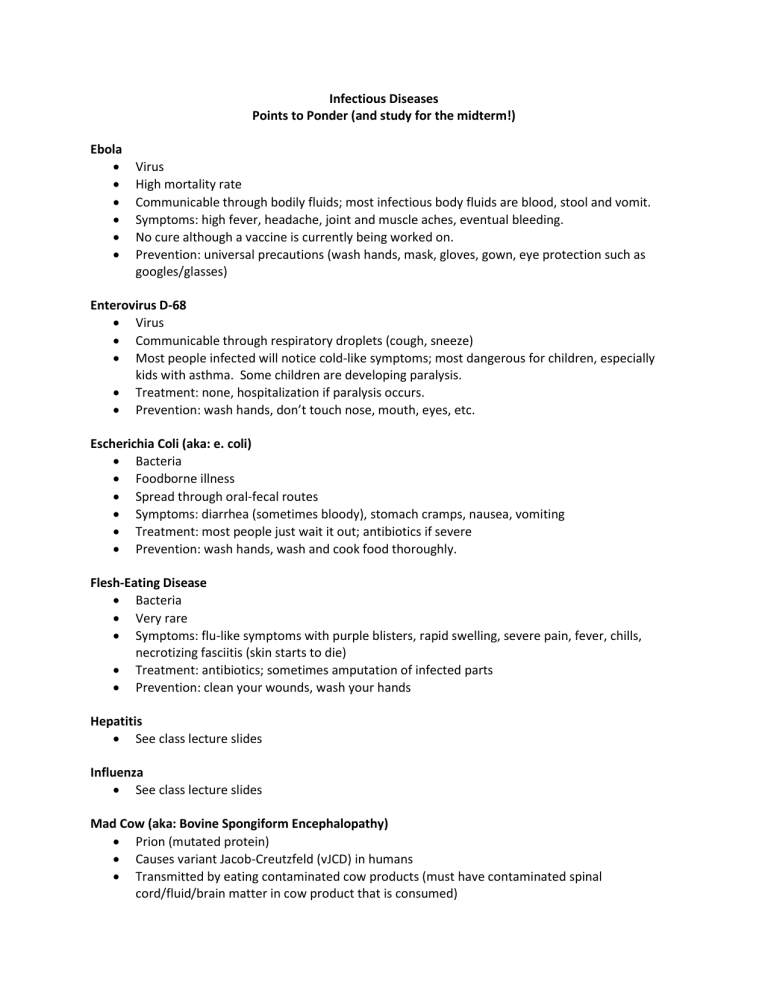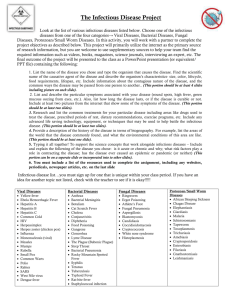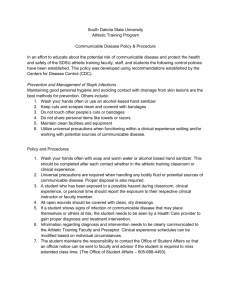Infectious Diseases: Ebola, E. Coli, Flu & More

Infectious Diseases
Points to Ponder (and study for the midterm!)
Ebola
Virus
High mortality rate
Communicable through bodily fluids; most infectious body fluids are blood, stool and vomit.
Symptoms: high fever, headache, joint and muscle aches, eventual bleeding.
No cure although a vaccine is currently being worked on.
Prevention: universal precautions (wash hands, mask, gloves, gown, eye protection such as googles/glasses)
Enterovirus D-68
Virus
Communicable through respiratory droplets (cough, sneeze)
Most people infected will notice cold-like symptoms; most dangerous for children, especially kids with asthma. Some children are developing paralysis.
Treatment: none, hospitalization if paralysis occurs.
Prevention: wash hands, don’t touch nose, mouth, eyes, etc.
Escherichia Coli (aka: e. coli)
Bacteria
Foodborne illness
Spread through oral-fecal routes
Symptoms: diarrhea (sometimes bloody), stomach cramps, nausea, vomiting
Treatment: most people just wait it out; antibiotics if severe
Prevention: wash hands, wash and cook food thoroughly.
Flesh-Eating Disease
Bacteria
Very rare
Symptoms: flu-like symptoms with purple blisters, rapid swelling, severe pain, fever, chills, necrotizing fasciitis (skin starts to die)
Treatment: antibiotics; sometimes amputation of infected parts
Prevention: clean your wounds, wash your hands
Hepatitis
See class lecture slides
Influenza
See class lecture slides
Mad Cow (aka: Bovine Spongiform Encephalopathy)
Prion (mutated protein)
Causes variant Jacob-Creutzfeld (vJCD) in humans
Transmitted by eating contaminated cow products (must have contaminated spinal cord/fluid/brain matter in cow product that is consumed)
May take years to decades for symptoms to appear
Symptoms: dementia-like; loss of coordination, memory loss
No cure, no treatment
Prevention: don’t eat contaminated cow products (how do you know???)
Meningitis
Multiple types: bacterial, viral, fungal, parasitic
Bacterial and viral are spread through respiratory droplets (coughing, sneezing, kissing)
Symptoms: Fever, headache, stiff neck, may also have nausea, vomiting, increased sensitivity to light or confusion.
Treatment: bacterial: antibiotics; viral; wait it out
Prevention: vaccine for bacterial/viral
Norovirus
Virus
Transmitted through touching infected surfaces, oral-fecal routes, being around an infected person; highly contagious.
Symptoms: nausea, vomiting, diarrhea, low grade fever, fatigue
Treatment: let it run its course, rest and fluids. Hospitalization may be necessary if dehydration occurs.
Prevention: hygiene – wash hands, clean and disinfect surfaces
Polio
See class lecture slides
Rhinovirus (aka: common cold)
Virus
Annoying but rarely fatal (unless it turns into pneumonia or other more serious disease)
Communicable through respiratory droplets (the dreaded cough/sneeze)
Symptoms: sore throat, runny nose, headache, cough
Treatment: rest, mom’s chicken noodle soup (this actually has scientific evidence behind it!)
Prevention: wash your hands! Don’t touch your nose, eyes, mouth
Salmonella
Foodborne illness
Bacteria
Symptoms include diarrhea, fever, abdominal cramps
Treatment: antibiotics if severe
Prevention: cook poultry, ground beef, eggs well.
Syphilis
Bacteria
Sexually transmitted infection
Symptoms include: sores, skin rashes, fever, swollen glands, sore throat, headache, fatigue.
Most people have no symptoms.
Treatment: antibiotics
Prevention: practice safer sex practices (condoms, oral sex precautions)
Tuberculosis
See class lecture slides
Don’t get too bogged down in the details – think about characteristics that make these unique.








